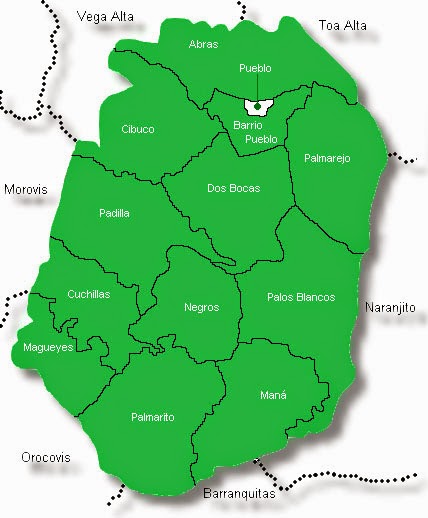 |
| Corozal, Puerto Rico [Google] |
Juana Negrón Chéverez was either born in one of two towns, Corozal or Toa Alta. She is from the part of my family that migrated towards Corozal as the town separated from Toa Alta. I’m guessing she was born in Corozal because I haven’t been able to find her in the baptismal records of Toa Alta. According to her death record, she was born about the 1820s. She could have been born a little early than that or maybe a little later, she I don’t have a birth or baptismal record for Juana I can’t be certain of how old she was when she died. Her death certificate says she was 100 years old and died on the 11th of November 1920 in Palos Blancos, Corozal, Puerto Rico. A lot of my family lived in the barrios of Palos Blancos, Dos Bocas, and Palmarejo, which lie on the western side of Corozal — closer to Toa Alta and even Naranjito.
Juana Negrón Chéverez was the legitimate daughter of Juan Negrón and María Chéverez. The surname Chéverez has always been of an interest to me and also appears on my mother’s side of the family – from the Toa Alta/Corozal area as well. The surname is sometimes associated with Taíno natives, such as Varin Chéverez Chéverez who was said to be a full-bloodied Taíno Indian from the town of Morovis. I’m not sure how many full-bloodied natives there were after the original population began to dwindle once the Spanish arrived. I do, however, know that the Taíno are being kept alive through our DNA and our maternal haplogroups. Juana Negrón Chéverez carried a native haplogroup from her mother María Chéverez and is still being passed down today to descendants of Juana Negrón Chéverez.
Juana Negrón Chéverez at one point, probably in Corozal, married her husband Juan/José Monserrate Marrero. I have been able to trace so far four of their children: María, Rosa, Casimira, and María del Carmen. I am a descendant from Rosa Marrero Negrón. Her husband must have passed away before 1885 according to many of the records I have found, which means that Juana Negrón Chéverez lived many years as a widow without her husband (a little over 35 years!)
Juana’s long life means that she was able to see the island of Puerto Rico go from a Spanish colony to that of a U.S. territory. She would have been around her 70s when the island was handed over and she then she lived another 22 years under United States rule. I would have loved to hear her stories of being under both Spanish and American rulings of the island. I can’t wait to start collecting stories from the older generations about living in Puerto Rico!
